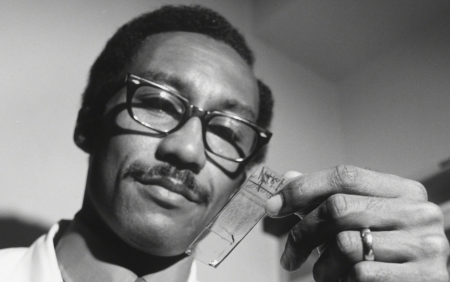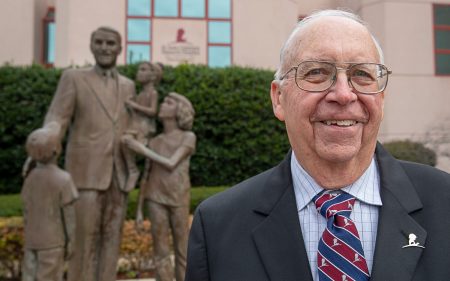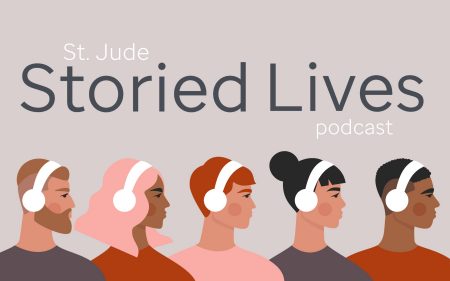
Legacy of a Cure: The Life of Dr. Brian Sorrentino
In a race against time, Brian Sorrentino, MD, saw his efforts in gene therapy pay off at the very end of his life. The St. Jude researcher helped introduce the word 'cure' to the devastating disease known as bubble boy.

November 26, 2019 • 8 min
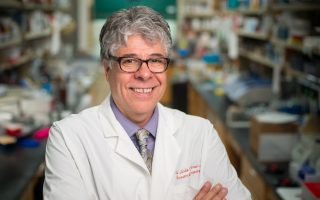
Colleagues chuckled when Dr. Brian Sorrentino, a tall, distinguished researcher known for his intensity and hard work, began wearing teddy bear-themed neckties and giddily greeting children who came in for checkups. He long ago had quit practicing medicine, after all, and normally worked in the lab.
But Sorrentino, director of the Division of Experimental Hematology at St. Jude Children’s Research Hospital, considered himself a physician-scientist, or, as he put it, a researcher with “the heart of a physician.” And as he led a clinical trial aimed at curing a rare, devastating immune disorder, he relished the chance to see whether the bold new gene therapy regimen developed by his team was helping living, breathing patients.
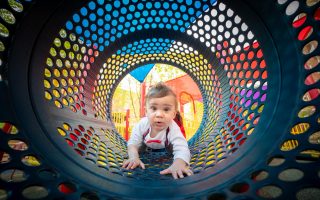
Omarion, born with a rare genetic disorder called X-linked Severe Combined Immunodeficiency, or bubble boy disease, explores playground equipment after his immune system was reconstituted through gene therapy developed at St. Jude Children’s Research Hospital. In the gene therapy, a normal copy of a defective gene was introduced into his stem cells, which then went on to produce the immune cells he had been lacking.
One of the first clear answers came on a summer day in 2017 when a baby from Peru was brought in for his nine-month exam. Treated some seven months earlier, the boy appeared to be thriving. Not only had he tripled in size, but his little body was churning out immune cells that allowed him to crawl and explore like a normal baby, without the sterile confinement usually required for kids born with the disorder known as bubble boy disease.
Sorrentino took a turn holding the baby and marveled at him. A photo from that day shows the 6-foot-3 scientist beaming a broad, toothy grin as he clutched the wide-eyed youngster.
“I held him and I said to myself, ‘I can’t believe we did this,’” he later recalled for the audience at an annual training event for ALSAC, the fundraising and awareness organization for St. Jude.
Sorrentino called it a “St. Jude moment” because it was then that he knew the gene therapy he had spent 15 years developing offered hope that children born with the disease could enjoy normal lives. He knew he was on his way to introducing the word ‘cure’ into the lexicon of a genetic disorder that long had defied easy solutions.
But there was one crucial fact Sorrentino didn’t know that summer day.
He didn’t know that while he absorbed himself in battling a deadly disease in these infants, it was he who was dying.
"Went at life with everything he had”
Brian Sorrentino lived fast, considering all he managed to squeeze into his 60 years. It seems only natural that he loved fast cars, a passion that drove indelible and defining memories of him. St. Jude President and CEO James R. Downing, MD, remembers visiting a racetrack near Memphis where Sorrentino and another hospital employee were testing their sports cars. Downing rode with both. The first driver was “smooth as silk” on the track, Downing recalls. Sorrentino was not.
“He was all over the track — he’s bouncing through the corners, his back end is fishtailing out. He’s hollering and screaming and having a blast.”
Later, the two drivers compared times. “The smooth-as-silk was faster,” Downing recalls, “but Brian had a lot more fun. That was Brian — Brian just went at life with everything he had.”
Sorrentino grew up mostly in the Hudson River Valley, an hour north of New York City. His older brother and only sibling, Brent, imparted in Brian his other main passion — music, taking him to see concerts at Madison Square Garden. Brian grew into such a Grateful Dead fan that after he became a father, listening to the group became a bedtime ritual with his kids.
Early on, Sorrentino was intent on following his radiologist father into medicine. That career choice likely was cemented by an ordeal that began when he was 17. He called his father to say he had found a lump on his chest near his neck. “Get on your bike and ride to my office,” was the response.
He was diagnosed with Hodgkin lymphoma, a cancer of the lymphatic system, part of the body’s immune defenses. Even in the mid-1970s, the disease was highly curable, but treatment involved chemotherapy mixed with massive doses of radiation to the chest.
Sorrentino completed treatment at a Bronx hospital and later went to medical school, then worked at the National Institutes of Health, where colleagues remember a researcher who was as humble and kind as he was brilliant and persistent. At NIH, Sorrentino trained under Arthur Nienhuis, MD, a hematologist and branch chief who in 1993 became the fourth medical director and CEO of St. Jude.
“He was thoughtful, careful in planning and he had a wonderful way of bringing people together,” Nienhuis said of the researcher he brought to St. Jude in 1994.
Targeting bubble boy disease
The disorder commonly called bubble boy disease has a scientific appellation that reads like a code: SCID-X1, for X-linked Severe Combined Immunodeficiency. Occurring perhaps once every 200,000 live births (15 to 20 babies annually in the U.S.), it’s an exclusively male disorder caused by a defective gene that renders babies unable to produce T-cells, B-cells and natural-killer cells — the pillars of the immune system. Without treatment, babies usually die in their first year from infection.
The condition can be cured through a bone-marrow transplant with a fully matched sibling donor, but most patients don’t have one. Transplants from half-matched parents only partially restore the immune system.

Gael, freed from the sterile isolation normally required for SCID-X1 patients, plays with his mom after his immune system was restored through gene therapy developed by the late Dr. Brian Sorrentino and his team at St. Jude.
Because it arises from a single gene defect, SCID-X1 became an early target for the budding gene-therapy field in the 1990s and early 2000s. In gene therapy, scientists insert a correct copy of the gene into a modified virus, which serves as a delivery vehicle for the gene and then “infects” stem cells to induce the production of immune cells.
A major problem, however, is that, much like a ball on a casino roulette wheel, there’s no way to predict where the virus will land on the cell genome. Early trials in France and elsewhere were halted after several patients developed leukemia because the virus they used activated adjacent cancer-causing genes.
“That put a stop to all gene therapy, literally a hiatus for the entire field,” Downing said. “Everyone in the field sort of thought, 'Well, this is not a problem we can overcome'.”
But at St. Jude, which was developing an ambitious gene-therapy program, Sorrentino and his team set out to prove otherwise.
He employed a hollowed-out form of the slow-incubating virus that causes AIDS, which has the added advantage of being efficient in infecting stem cells. To eliminate the risk of triggering cancer, Sorrentino put insulators on the virus to keep it from activating other genes. The final component of the therapy, refined by the University of California San Francisco Benioff Children’s Hospital, employed low doses of chemotherapy to clear space in the bone marrow.
Triumph and tragedy
As he and his team worked to launch a clinical trial to test the gene therapy on newborns, Sorrentino was going through personal transformations, as well. Previously divorced, with two grown children, he married again in 2015.
“He was just so much fun to talk to….a marvelous man,” said Suzanne Sorrentino. She also noted her new husband’s passion for St. Jude, how it was elevated by his own childhood cancer experience. “He had a lot of empathy for the families and the children here because he had lived it, too.”
But Sorrentino’s cancer-treatment history had been surfacing in bad ways, as well. The after-effects of the radiation caused thyroid problems and forced him to have an aortic valve replaced. Later, a pacemaker was installed to regulate his radiation-damaged heart.
The SCID-X1 clinical trial, however, was going well, much better than previous therapies, with patients safely developing functional immune systems within three months, said Ewelina Mamcarz, MD, a St. Jude bone-marrow specialist and lead author of the study. "I think what made the difference on this trial was the combination therapy," she said, referring to the use of chemo drug with the modified virus as a transport vehicle.
One of the biggest challenges had been enrolling enough patients, given the rarity of the disease. Half came from other countries, including the Peruvian boy named Gael.
Sorrentino seemed especially elated to get out of his lab and see the kids. “I’ve never seen him as happy as with the patients,” Mamcarz said.
But less than a month after Gael’s exam, Sorrentino was diagnosed with lung cancer — the final, tragic sequel to that medical drama of his own. The news came as a shock because he had assumed the breathing problems he experienced that summer signaled more heart trouble.
“Brian was just crushed by the diagnosis because he was at the peak of his career. His clinical trial was underway, children’s lives were being saved…,” Suzanne said. “He had everything to live for.”
In a bitter irony, Sorrentino sought to enroll in a clinical trial for his disease even as he led one for SCID-X1. But his weakened heart disqualified him.
As a physician, he knew his condition was terminal. “Then it kind of just became a race against time to see how much could he get done before the disease took its toll on him,” Suzanne said.
The diagnosis, indeed, gave new urgency to Sorrentino’s work. He continued to work at the hospital until he was too weak, and then monitored the project from home. Sometimes, his colleagues came to his house, working for a few hours, ordering pizza, then working more.
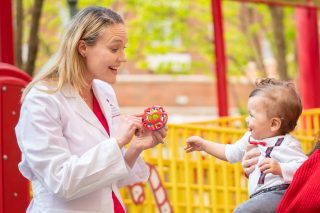
Ewelina Mamcarz, MD, plays with patient Omarion, who was part of the clinical trial for SCID-X1.
A bittersweet legacy
A week before Sorrentino’s death in November 2018, Mamcarz drove to his home, opened her laptop and showed him the data and the transcript of the paper on the SCID-X1 trial that would be submitted to the prestigious New England Journal of Medicine. By then he was so sick that he kept pain medicine nearby. But looking at the paper — seeing proof that his gene therapy worked — comforted him. The two doctors high-fived each other and shrieked with joy.
“After seeing the data, he said that was the best pain medicine that he could get,” Mamcarz said.
In one of his last conversations with his wife, Sorrentino said he felt he had been saved from lymphoma because there was “something big” he was meant to accomplish. “With the clinical trial underway and children’s lives being saved, he realized that he had reached that goal and it was time for him to go,” Suzanne said.
Days later, Sorrentino’s priest arrived to administer last rites.
In April 2019, six months after Sorrentino’s death, the New England Journal of Medicine published the SCID-X1 study, which reported that the first eight patients treated either had fully reconstituted immune systems, or were progressing toward it.
Since then, four additional patients have been treated -- with the same success. Kids who otherwise would have no immune protection can hug their parents, attend birthday parties and go on vacations. “Truly, the results continue to be outstanding,” Mamcarz said.
In another honor that Sorrentino didn’t live to see, Smithsonian magazine in November announced that it would bestow its American Ingenuity Award in Life Sciences on two members of his SCID-X1 team, Mamcarz and Stephen Gottschalk, MD, chair of St. Jude's Department of Bone Marrow Transplantation & Cellular Therapy.
Brent Sorrentino, however, said his humble brother was less interested in awards and recognition than he was in other measures of success.
“There are a dozen and counting kids alive today because of my brother,” he said.
Brian knew the radiation effects might rob 20 years from his life, his brother said. But the treatment had given him 40 years, too, and he used that time to bequeath decades of life to kids born with SCID-X1. “Brian said, to him, that’s a good trade.”
What’s left for friends and colleagues to remember, then, are the many sides to Sorrentino — the one who hurtled around that racetrack with abandon, going at life with everything he had, and the one who kept careful score and, by his reckoning, came out way ahead.




